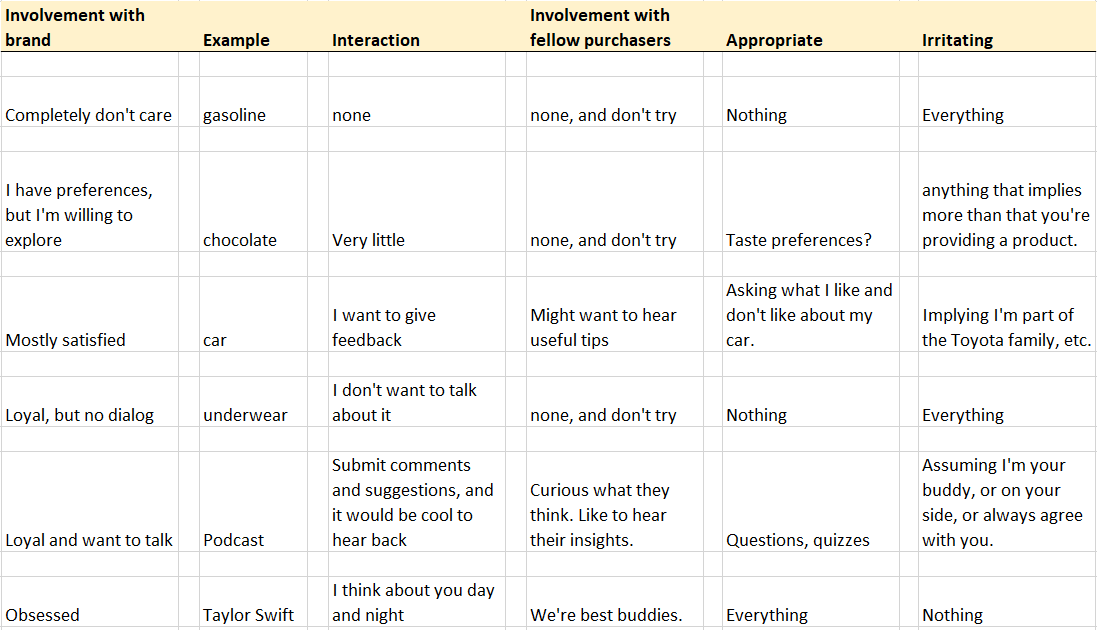Bob Hoffman thinks it’s a marketer’s delusion to believe that anybody wants to interact with your brand. I tend to agree with him. But my friends Lev Kaye and Leslie Laredo believe there are some situations where interaction is appropriate.
How do you decide when?
That’s the point of The Krehbiel Brand Involvement Matrix. It’s a first attempt to create a framework for deciding when and how much customer pestering is appropriate.
Involvement with the brand: None. I completely don’t care.
Example: Gasoline.
Interaction: None.
Involvement with fellow purchasers: None, and don’t try.
Appropriate communication: Nothing.
Irritating communication: Everything.
Involvement with the brand: I have preferences, but I’m willing to explore.
Example: Chocolate.
Interaction: Very little.
Involvement with fellow purchasers: None, and don’t try.
Appropriate communication: Ask about taste preferences?
Irritating communication: Anything that implies there’s more here than you providing a product that I purchase.
Involvement with the brand: Mostly satisfied.
Example: Car.
Interaction: I want to give feedback.
Involvement with fellow purchasers: I might want to hear useful tips from other owners.
Appropriate communication: Asking what I like and don’t like about my car.
Irritating communication: Implying I’m part of the Toyota family and cringy stuff like that.
Involvement with the brand: Loyal, but no dialog.
Example: Underwear.
Interaction: I don’t want to talk about it.
Involvement with fellow purchasers: None, and don’t try.
Appropriate communication: Nothing.
Irritating communication: Everything.
Involvement with the brand: Loyal and want to talk.
Example: A podcast.
Interaction: I might want to submit comments and suggestions, and it would be cool to hear back.
Involvement with fellow purchasers: I might be curious what they think, and I’d like to hear their insights.
Appropriate communication: Quizzes, questions.
Irritating communication: Assuming I’m your buddy, or on your side, or always agree with you.
Involvement with the brand: Obsessed.
Example: Taylor Swift.
Interaction: I think about you day and night. (Not me, but the Swifties.)
Involvement with fellow purchasers: We’re best buddies.
Appropriate communication: Everything.
Irritating communication: Nothing.
So there you have it. The Krehbiel Brand Involvement Matrix. How can I improve it?





Hi Greg, I do think you can improve on your illustration and the concept of appropriate interaction: think loyal customers. You need to recognize that all customers aren’t created equal. Marketers drive brand awareness towards justification for a reason- we want to be the chosen one for that customer. But not all customers are willing to be loyal.
Loyal customers will allow more ‘pestering’ than a broader audience target because they have proved their interest by multiple purchases or longevity. B2B and B2C brands can identify loyal followers within many channels and poll/survey for feedback or target with rewards and discounts. Recognizing customer loyalty is still an important part of brand maintenance as it is more expensive to replace a current customer with a new one.
Does each of the above examples actually have loyal customers that can be identified? Your organization in the chart above ties this logic that loyal customers will be more involved with their chosen brands. Gasoline has the most difficult task (does anyone patronize gas stations based on the name of the oil company?) yet I know people who only by clothing, canned tomatoes or chocolate specifically from one brand.
Yes, I agree that customers are different, and some people have a favorite brand where in many cases I’ll just buy whatever’s cheap.
What I object to — and what I’m trying to address in this matrix — is a sort of generalized idea that the goal of marketing is to get people to fall in love with your brand. I think that’s ridiculous. There are a few situations where people love a brand, but most of the time they don’t care, and the very attempt to get them to love the brand will annoy them.